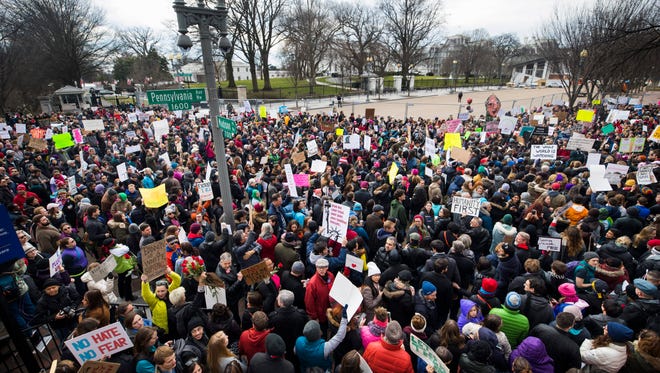Chaos reigns amid legal battle over Trump's immigration ban

Forty-eight hours after President Trump signed an executive order temporarily banning immigration from seven predominantly Muslim countries, chaos reigned at U.S. airports, as authorities, travelers and lawyers struggled Sunday to understand how the ban is being implemented.
Attorneys for civil rights and immigration advocacy groups said Customs and Border Protection agents are interpreting Trump's orders differently. At some international airports, including Chicago, Atlanta and Dallas, all people who were detained have been allowed to enter the United States. At others, including San Francisco, Los Angeles and New York's JFK International Airport, lawyers said an undetermined number of travelers remained in custody.
Three federal courts — in New York, Virginia and Boston — have issued rulings since Saturday night to protect people who were in transit to the U.S. when the order went into effect Friday and got caught in legal limbo. The ban affects people from Iran, Iraq, Libya, Somalia, Sudan, Syria and Yemen.

The Department of Homeland Security said that as of Saturday night, 109 people had been detained, but it has yet to follow through on a New York judge's order to release a list of all people still being detained, including travelers who may have arrived on U.S. soil Sunday.
The result? "Mass confusion," said Lee Gelernt, deputy director of the ACLU's Immigrants' Rights Project who argued the case in New York. "The government took no steps to make sure that people understood what the order means and how it should be implemented. (Trump) just threw it out there without ensuring that it would be implemented fairly and even-handed and properly."
Protests against Trump's immigration plan rolling in more than 30 cities
The White House and Homeland Security countered that they provided new guidelines to agents working at airports and that only a small fraction of travelers were affected by the order. On Saturday, when asked about the roll-out of his executive order, Trump said "it's working out very nicely." And several White House officials appeared on Sunday talk shows to say that civil rights groups were blowing the confusion out of proportion.
So where do things really stand?
A ruling issued late Saturday by U.S. District Judge Ann Donnelly in New York barred Customs and Border Protection officials across the country from deporting any immigrants, including refugees and legal immigrants from the seven predominantly Muslim countries targeted in Trump's order, so long as they hold a valid visa. That order dealt only with immigrants who had already arrived in the U.S. or were already in transit.
Homeland Security said it would comply with that order, but made clear it would continue carrying out Trump's executive order, meaning they will try and stop any other refugees or legal immigrants from the seven countries listed in the president's order from heading to the U.S.
Lawyers will soon begin arguing the overall legality of Trump's executive order, a possibly weeks-long process that will ultimately determine whether the order is allowed to stand.
Experts question legality of Trump's immigration ban on Muslim countries
But much remains unclear.
Part of the problem has been the lack of information coming from the departments of Homeland Security and State.
The first official mention of the new guidelines to appear online came from an Arabic-language Twitter account run by the State Department. It sent out three tweets on Saturday instructing citizens from the seven countries listed in Trump's order not to travel to the U.S., pay any visa fees or show up for visa interviews. The tweets did not mention, however, that those with permanent resident status — or green-card holders — from those countries are still allowed to enter the U.S.
Homeland Security said it provided new guidance to all of its port officials immediately after Trump signed the order, and updated its computerized targeting system to identify those people. But the department did not start providing guidance to travelers until Sunday.
Homeland Security's first tweet came early Sunday, which linked to the department's statement declaring that it would carry out Trump's order and that "prohibited travel will remain prohibited." There was no guidance on which travelers should stay home and no clarification of how the order affected green-card holders.
It wasn't until Sunday night that Homeland Security Secretary John Kelly declared that he had deemed "the entry of lawful permanent residents to be in the national interest." That leaves refugees and people entering the country on temporary visas, such as for business and tourism, barred from entering the country.
The web sites of both agencies made no mention of the new order as of Sunday evening.
Rep. Raul Labrador, R-Idaho, echoed the sentiments of many Republicans when he praised Trump for his executive order, arguing that the U.S. vetting system was overdue for an overhaul. But he criticized the way it’s been carried out.
"(The administration) failed to provide clear guidance on the policy which caused substantial confusion at the ports of entry," Labrador said. "Inadequate review and poor implementation of this executive action threatens to undermine otherwise sound policy."